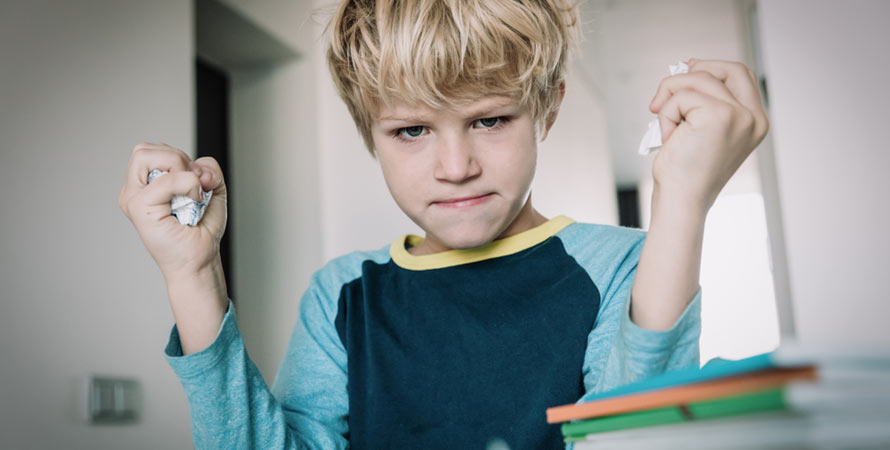Introduction
Disruptive behavior disorder (DBD) is a form of behavior disorder characterized by ongoing patterns of hostility and defiance towards any authority figure.
It is common amongst kids and adolescents. While almost every child goes through periods of testing limits by acting out, kids with a disruptive behavior disorder take it to the extreme, affecting their lives and the lives of those around them.
The oppositional defiant disorder is similar to impulse control disorder, but it usually presents itself early on. It is characterized by defiance, hostility, and disobedient behavior directed towards parents, teachers, and other forms of authority.
Early intervention, taking an intermittent explosive disorder test, and therapy may help keep these behaviors from escalating into higher-risk behaviors that can lead to more dire consequences.
Now, keep reading to determine what triggers these disorders, the symptoms, and the best course of disruptive behavior disorder treatment.
Causes Of Disruptive Behavior Disorder Explained
Physicians and researchers believe there is no one ‘size fits all’ when it comes to the causes of disruptive behavior disorder. However, many believe it springs from various factors working together:

1. Behavioral Factors
According to a Phenotypic Study of Cognitive and Emotional Deficits[1], defects or injuries to various brain areas may help trigger behavior disorders.
Disruptive impulse control and conduct disorder have been linked to particular brain regions regulating behavior, emotions, and impulse control. Conduct disorder symptoms might occur if the nerve cell circuits in those cognitive regions do not work properly.
Moreover, kids with impulse control disorder have other mental issues like anxiety disorder, attention deficit disorder (ADHD), depression, and substance abuse, leading to control and conduct disorder.
2. Genetic Factors
Kids with disruptive impulse control and conduct disorders might have family members with mental illnesses such as anxiety disorders, mood disorders, and personality disorders. Studies show that 50% of the variance in disruptive behavior disorder is attributable to genetic influences. However, affected kids have also been shown to come from healthy families that function well.
3. Environmental Factors
The conditions that kids grow up in may also significantly impact whether or not they develop disruptive behavior disorder. If a chaotic home life surrounds a child, they might start acting out simply because it enables them to have some form of control (since they have no power over the chaos occurring around them). Similarly, kids raised without appropriate discipline or whose guardians are consistently absent can experience significant impacts on their behavior.
Atypical mother-child interaction[2] during the first year of birth has impacted early-onset disruptive behavior disorder.

4. Social Factors
Low socioeconomic status and not being accepted by their peers can trigger conduct disorder in kids and adolescents.
5. Risk Factors
Other disruptive impulse controls and conduct disorder causes include:
- Exposure to violence – video-game games, domestic violence, etc.
- Being male
- Living in an urban environment
- Lying in poverty
- Family history of conduct disorder, mental illness, and other psychiatric disorders
- Having parents who abuse drugs and alcohol
- Family dysfunction
- Being abused or neglected
- History of experiencing traumatic events
- Symptoms Of Disruptive Behavior Disorder
Kids with disruptive behavior disorder show repeated and persistent patterns of anger, backtalk, defiance, and difficulty managing and regulating their emotions. Some might even show hostile or aggressive behavior towards other kids and grownups. The behavior is typical, what you might see in a normal kid, but more intense, frequent, and difficult to control.
Additionally, children with oppositional defiant disorder (ODD) tend to show less aggressive-disruptive behavior disorder symptoms compared to those with conduct behavior disorder. Individuals with ODD history are at extreme risk of severe emotional adjustment difficulties, including substance abuse and suicide. Moreover, more than 90% are likely to be diagnosed with otherwise mental issues.
Some disruptive behavior disorder symptoms of ODD include:
- Blaming others for their mistakes
- Purposely annoying others
- Memory impairment
- Easily triggered by others
- Frequently arguing with adults
- Regularly throwing temper tantrums
- Often vindictive and spiteful – they seek revenge at all costs
- Resistance to authority –blatantly refusing to follow the rules or comply with instructions.
- Conduct disorder (CD), on the other hand, is more severe and might be associated with extremely violent and aggressive acts. It is often diagnosed as ODD in younger kids.
- Children with conduct disorder intentionally ignore or cause other people’s rights and feelings.
Common disruptive behavior disorder symptoms of CD include:
- Abusing animals
- Bullying
- Misinterpreting others’ behaviors as threatening
- Skipping school
- Vandalizing property
- Refusal to follow the rules or instructions
- Stealing
- Substance abuse
- Lying
- Lack of guilt or remorse
- These behaviors occur in numerous settings and might be aimed at classmates, parents, siblings, teachers, and other kids.
Recommended Treatments For Disruptive Behavior Disorder

Treatment for disruptive behavior disorder is based on numerous factors, including the kid’s age, the severity of symptoms, and the child’s ability to participate in specific therapies. Treatment typically consists of the following:
1. Cognitive Behavioral Therapy
The most common disruptive behavior disorder treatment form is child behavior therapy (CBT). To help your child improve their behavior, a CBT therapist will use techniques such as:
2. Behavior charts
Figuring out the desired behaviors and rewarding the occurrence of such behaviors, usually with a chart, improves the chances of the child practicing the behaviors
3. Role-play
Helping the child develop healthy communication and coping skills by playing the part of other people in therapy sessions
4. Modeling
Displaying the type of actions they would want the child to mirror.
5. Medication
After conducting an intermittent explosive disorder test, a physician might recommend medication as a course of treatment. And even though these meds are not usually meant for a disruptive behavior disorder, they can help in instances when the symptoms remain despite therapy.
Some medication options for disruptive behavior disorder include:
- Antipsychotics – This helps reduce symptoms of disruptive behavior disorder. They are available in Abilify, Risperdal, and Geodon.
- Non-stimulant ADHD meds – Medications like Strattera and Intuniv could help reduce ODD symptoms and conduct disorder.
- Stimulants – Psychiatrists frequently prescribe stimulant meds to treat attention deficit/hyperactivity disorder in both kids and adults. Some of the favorable options for DBD include Adderall, Focalin, and Ritalin.
6. Play Therapy
Younger kids with DD might benefit from play therapy. These sessions involve children playing with toys like dolls, puppets, and sand trays to help them express ideas they might have trouble articulating. In-play therapy[3], the therapist will:
- Provide your child with warmth and positivity
- Help the toddler communicate and process their feeling and thoughts
- Provide your kid with encouragement and safety
- This form of treatment aims to help the child minimize unwanted behaviors and symptoms.

7. Parent-Child Interaction Therapy (PCIT)
PCIT is an innovative, disruptive behavior disorder treatment. It combines psychoeducation, parent training, and other treatment courses. During this form of therapy, a therapist observes the interactions between the child and their parents while providing recommendations and encouragement to the parent via an earpiece without the kid’s knowledge.
It helps a parent recognize the emotional impact of having a kid with DBD and better understand their moods and actions. By identifying and regulating their emotions, parents create a more stable and supportive home for their children.
How To Understand & Deal With Disruptive Behavior Disorder
You can better understand your child’s behavior pattern and help them deal with it by:
1. Seeking Professional Help
If you suspect your child has disruptive behavior disorder, you need help. Your kid’s pediatrician may refer you to a child therapist. These professionals could help evaluate your kid’s behavior and help diagnose the condition. They might do so by putting them through the intermittent explosive disorder test, talking to your child and other family members, or observing your child in a controlled environment.
It might help them better understand your child’s behavior pattern and advise you regarding the best course of disruptive behavior disorder treatment.
2. Praising Positive Behavior
It is easy to place all your focus on the negative. So, ensure you take the correct steps in noticing and praising positive behaviors. Praise is an ideal way of increasing good behaviors and encouraging your child to engage in positive behaviors.
3. Taking Care Of Yourself
Dealing with a child with a disruptive behavior disorder could be stressful. Therefore, ensure you find ways to manage your stress and anxiety levels, whether it is through walking, meditation, yoga, or conversing with friends.
4. Sign Up for A Support Group
It would be best if you also encouraged your child to seek help from other people with behavior disorders. Your family child therapist might recommend one such group.
The Bottom Line
Disruptive behavior disorder might be distressing for both kids and parents. Fortunately, there are treatments to help manage them. Your doctor will conduct an intermittent explosive disorder test and develop the best course of treatment.







